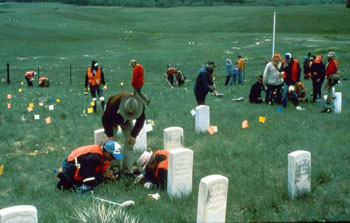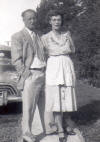| Friends Of The Little Bighorn Battlefield |
The Next Generation In The Study Of Custer's Last Stand |
Uncovering History |
| • The Battle • Archeology • Memorials • Little Bighorn Store • News • Book Reviews |
Uncovering History: Archaeological Investigations at the Little BighornBy Douglas D. ScottBook Review by Robert Utley, April 24, 2013
Crew working Last Stand Hill, 1984 survey Photo courtesy Little Bighorn Battlefield National Monument
Bob Reece has invited me to comment on Doug Scott’s recent book summarizing his almost forty years of supervising archeological investigations at the Little Bighorn Battlefield. In part, my selection results from my long association with the battlefield. This began in 1947, my first summer as a seasonal “historical aide.” I spent six summers, until 1952, at the battlefield interpreting the story for visitors, first atop Last Stand Hill, then, after the new visitor center opened, from the observation room at one end of the building.
Photo courtesy Robert Utley
My superintendent was “Cap” Edward S. Luce, himself a veteran of the Seventh Cavalry. Luce is only one of the men Scott identifies as instrumental in some of the early efforts at archeology whom I knew, including R. G. Cartwright, W. S. Nye, Joe Blummer, Henry Weibert, and others. I even assisted Luce in futilely sweeping parts of Nye-Cartrwright Ridge with World War II minesweepers. The "historical aide" Robert Utley working the minesweeper, LIBI, 1948 photo shot by Supt Edward Luce "Finally I assembled my uniform from the Park Service...I couldn't afford the $20 Stetson, so substituted a war-surplus olive green sun helmet." Custer and Me photo courtesy Robert Utley
Read our interview with ScottBooks On The Horizon Home |
|
|||
|
Copyright 1999-2013 Bob Reece Friends Little Bighorn Battlefield, P.O. Box 636, Crow Agency, MT 59022 | Home |
Board of Directors |
Guest Book | Contact | Site Map
| |
||||


